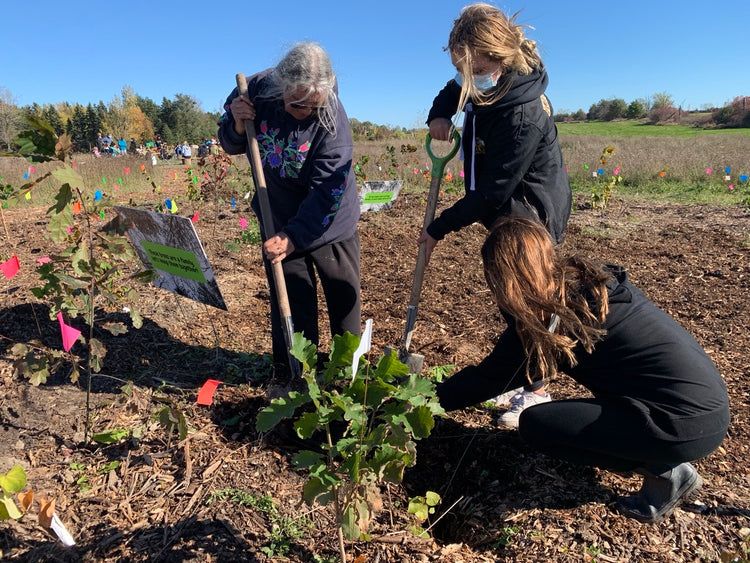Walking the Path to Peace Together – Kingston Indigenous Languages Nest – planting a Little Forest
Nindazhiikewinaan Our community:
The Little Forest on HWY 15 is planted on 2.86 acres of pasture located in the peri-rural area of east Kingston. This site is owned by the United Church of Canada and was intended to be the future site of the Faith United Church building. In the spirit of Truth and Reconciliation, the Faith United community and the local Indigenous community began several years of conversation, relationship building, and consultation, culminating in the United Church's commitment to repatriate the land to the Katarokwi urban Indigenous community and the formation of the Walking the Path of Peace Together land council. The land is important for cultural and language revitalization. The Kingston Indigenous Languages Nest (KILN), committed to land-based culture and language revitalization supported the planting of the Little Forest with TD Friends of the Environment funding. Our community is in relationship with the land – we are kin relatives. We see ourselves as part of the ecosystem web of kin relations. A key belief is that the land, the humans, and all beings are the community.
Izhitwaawin
- Katarokwi is the place where Indigenous ancestral relations have lived, including the Wendat, Haudenosaunee and Algonquian Indigenous communities. These communities harvested and cultivated food and medicines, created community, family, and extended family, and practiced and evolved cultural ways and teachings in this area.
- Indigenous languages and cultural ways arise out of this relationship with the land.
- The land today endures the impact of colonization: 80% of the forest has been removed with the attendant loss of habitat. Industrialization, western agriculture practices and urbanization has changed the landscape, soils, and waters.
- We understand that we exist in an ecosystem of kin relations
- Repatriation, although a legal procedure, begins in the heart. True repatriation begins with loving care of the land and All Our Relations.
- The planting of the Little Forest is an expression of seven generations’ thinking. We fully intend that the Little Forest will thrive and reach maturity and in so doing will call back more biodiversity to the air, the land, and the soil.
Aki & Mitigwaakiins:
The land, shaped like a diamond, runs parallel to HWY 15. HWY 15 is a busy commuter road and access point to the 401. This roadway gives rise to loud traffic sounds over half of the property. The difference in elevation between the high and low points of the land is about 8 feet. There are wetland characteristics on the lowest border of the land, with spring peepers calling, still audible over the noise of traffic. The land had been left fallow and mowed for 20 years or more. In the last year, there has been no mowing. There are no mature trees, except for some burr oak and tall nannyberry bushes on the property line. The sky is wide open. An adjacent field and hardscaped industrial/commercial complex are the runways for powerful late-afternoon southeast winds.
There is an Indigenous Food Sovereignty Garden with vegetable, pollinator, and medicine gardens. Many songbirds nest and subsist on the land. In the fall, the path of migrating nikag (geese) and other bineshiinhyag (birds) track across the sky. There is an Osprey nest in the distance, and we frequently see other birds of prey hunting or flying at great heights as they make their way towards the Cataraqui River. Small mammals also live on the land, mice, voles and rabbits and weasels, as well as reptiles like garter snakes. There are many pollinators and insects, with a plethora of praying mantis, ticks, bees, butterflies, and flies, in various stages of their lifecycles.
The little forest is 300 m2, with approximately 60% canopy trees, and 40% shrubs (see figures 1 and 2) planted in a community that favours upland conditions and wetland conditions. There are three plants per m2, consistent with a Miyawaki-inspired approach. About 80% of the trees were planted by children and families.
Why we planted a little forest
The WTPPT land council agreed to plant a little forest as it was in keeping with the desire to nurture biodiversity, respond to the climate crisis and restore native species back to the land, and thereby also support the restoration of the soil as it partnered with the roots of the Little Forest. Kingston Indigenous Languages Nest sought funding to support the planting of trees as a cultural and language revitalization activity.
Gaa-zhi-maajtaawaad
Biboong 2021
Biboong 2021 the WTPPT Land Council convened a sacred fire and circle to consider the request by an Indigenous community member to plant a Little Forest on the land. The consensus was reached through this process.
In the following months, Indigenous community members met online to remember tree relations and to reflect on the relationships, practices and personal stories about specific trees or tree species.
Contemporaneously, the Kingston Indigenous Languages Nest received a grant from the TD Friends of the Environment to support the purchase of trees and soil amendments to contribute to planting three Little Forest sites: WTPPT site - Hwy 15 Lakeside Community Garden and Wolfe Island site.
In the spring, summer and fall community volunteers undertook the work to prep the forest floor and plant trees. A key group of tree coaches were trained on our planting protocol. The Tree Coaches worked with volunteer planters in a 1:3 ratio. Over 250 volunteers, including classes of school children, the Kingston Indigenous Languages Nest and Kahwat:sire Program participants contributed to the Forest planting at highway 15 alone.
Nimbamitoonaa
First and foremost, we will continue to co-create our reciprocal relationship with the land. Cultural and language revitalization is the pathway to this relationship. Ceremony, Asemma offerings and singing and Landcare activities are the roots of this relationship. This mutual relationship is the necessary condition to ensure our mutual survival.
We have a calendar of seasonal care activities that include monitoring survival rates, application and removal of tree tubes, and other observations such as temperature, rainfall, budding out and the presence of invasive species. We hope to promote a native species ground cover in year 3.
A watering system based on rainwater collection from a sun shelter roof, constructed by volunteers, will be the main source of watering for the little forest.
Aki:
Mnookmik 2021
Locating the site to plant the forest was done through ceremony, walking the land, observing the contour and movement of water during heavy rainfall, and identifying a wetland area. A site-based soil test and two soil lab tests were also undertaken. Volunteers set out a 1 m2 grid with twine and flags to help provide a visual guide for the future planting.
The forest floor was prepared using a no-dig method: tall pasture grass was mowed. Cardboard, compost, and woodchips were layered. During the summer, the soil was collected from a nearby mature forest again using the Asemma protocol, and many children put their Asemma down on the forest floor.
Species Selection:
Figure 1 Lowland (Wetland)
Figure 2 Upland Forest
Our Eco-region is 6E, a temperate hardwood forest. The species lists for each forest type were generated by Joyce Hostyn, a Master Gardener, in consultation with WTPPT volunteers. A total of 900 saplings were planted in 300 m2, with about 49 different species.
Advice to other communities
- It is important to ensure that the trees will survive, and site selection is key to determining if the titleholders of the land will protect the trees to maturity and beyond.
- The Little Forest is a relationship waiting to happen with communities, schools, and individuals. It is hopeful climate action, and an act of love to plant for the survival of All Our Relations and the future generations.
- Pay attention to the land. The landscape will tell you what community of trees and shrubs will do well in the landscape. Think about the sources of water. Watering, weeding, and protecting the forest is a responsibility we humans must carry for the first three years.
- Think of your community and invite people to learn and to lead in the care of the forest.
- Draw on the greater community resources such as municipal wood chips, compost, and manure.
- Reach out to Little Forest Kingston for advice, fundraising, training, and encouragement.
Indigenous Languages Glossary (Anishinaabemowin):
- Aki & Mitigwakiins: the land and the little forest
- Biboong – it is winter
- Bineshiinhyag – bird
- Gaa-zhi-maajtaawaad – How we started
- Izhitwaawin: a certain way of belief
- Mnookmik: be spring
- Miitigwaakiing – In the forest
- Mitigwaakiins – Little Forest
- Nimbamitoonaa Mitigwaakiins – we care for it
- Wiikshkaa (vai) – be pulled in a certain direction by an unseen force, be drawn in a certain
- Nindazhiikewinaan – Our community – derived from the verb Dazhiike. Dazhike means to take time, spend time or stay or play in a certain place.

